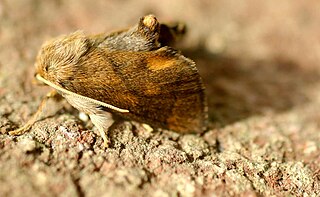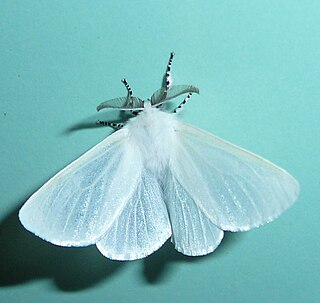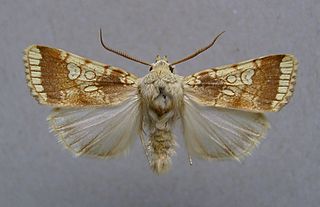
The cinnabar moth is a brightly coloured arctiid moth found as a native species in Europe and western and central Asia then east across the Palearctic to Siberia to China. It has been introduced into New Zealand, Australia and North America to control ragwort, on which its larvae feed. The moth is named after the red mineral cinnabar because of the red patches on its predominantly black wings. The species was first described by Carl Linnaeus in his 1758 10th edition of Systema Naturae. Cinnabar moths are about 20 mm (0.79 in) long and have a wingspan of 32–42 mm (1.3–1.7 in).

Eacles imperialis, the imperial moth, is a member of the family Saturniidae and subfamily Ceratocampinae. It is found mainly in the East of South America and North America, from the center of Argentina to south Canada. The species was first described by Dru Drury in 1773.

The Limacodidae or Eucleidae are a family of moths in the superfamily Zygaenoidea or the Cossoidea; the placement is in dispute. They are often called slug moths because their caterpillars bear a distinct resemblance to slugs. They are also called cup moths because of the shape of their cocoons.
The Folkestone Downs are an area of chalk downland above Folkestone, where the eastern end of the North Downs escarpment meets the English Channel. Part of the Downs is the Folkestone to Etchinghill Escarpment Site of Special Scientific Interest, designated for its geological and biological interest.

Udea ferrugalis, the rusty dot pearl, is a moth of the family Crambidae. The species was first described by Jacob Hübner in 1796.

Katha depressa, the buff footman, is a moth of the family Erebidae found in Asia and Europe. It was first described by Eugenius Johann Christoph Esper in 1787.

Leucoma salicis, the white satin moth or satin moth, is a moth of the family Erebidae. The species was first described by Carl Linnaeus in his 1758 10th edition of Systema Naturae. It is found in Europe including the British Isles but not the far north. In the east it is found across the Palearctic to Japan. Also in North America where it was introduced in the 1920s.

Aspitates is a genus of moths in the family Geometridae, native to Eurasia and North America.

Batrachedra praeangusta is a moth of the family Batrachedridae which is native to Europe. It is also found in North America. It was first described by Adrian Haworth in 1828 from the type specimen found in England. The foodplants of the larvae are poplars and willows.

Colobochyla interpuncta, the swamp belle or yellow-lined owlet, is a moth of the family Erebidae. The species was first described by Augustus Radcliffe Grote in 1872. It is found in North American wetlands from Wisconsin to Nova Scotia south to Florida and Texas.

Ditula angustiorana, the red-barred tortrix, is a moth of the family Tortricidae found in Africa, Asia, Europe and North Africa. Other common names are the fruit-tree tortrix and the vine tortrix. The moth was first described by Adrian Hardy Haworth in 1811.

Aspitates gilvaria, the straw belle, is a moth of the family Geometridae. The species was first described by Michael Denis and Ignaz Schiffermüller in 1775. It is found from Europe to the eastern part of the Palearctic realm. The main habitats are warm slopes, heathlands, fields and abandoned quarries. In the mountains, the species rises to heights of 1000 meters. Adults are on wing from July to August.

Aspitates aberrata is a moth of the family Geometridae first described by Henry Edwards in 1884. It is found in North America from northern Minnesota north and west across southern Manitoba to western Alberta and the Peace River area of British Columbia. The habitat consists of open aspen parklands and low elevation grasslands.

Schistostege decussata is a moth of the family Geometridae. It is found in south-eastern and eastern Europe up to Ukraine. In Hungary and Lower Austria, the yellow-brown form is found.

Scotopteryx luridata, the July belle, is a species of moth in the family Geometridae. It is found in most of Europe, except Finland and the Baltic region. Further East it is found in Turkey, Georgia and Transcaucasia.

Scotopteryx mucronata, the lead belle, is a species of moth in the family Geometridae. It is found in most of Europe, Turkey, Ukraine, West Siberia.

The heart moth is a species of moth of the family Noctuidae. It is found locally in Europe. It is also present in Turkey, Transcaucasia, the Caucasus, Israel, Iran and Iraq.

Euchlaena madusaria, the scrub euchlaena moth, is a species of moth of the family Geometridae. It is found in North America, where it has been recorded from British Columbia, east to Nova Scotia, south to Florida, Missouri and Oregon. The habitat consists of dry woodlands. The species is listed as threatened in Connecticut.
The Isles of Scilly are an archipelago 45 km (28 mi) off Land's End, Cornwall. Little of the fauna on, above or in the seas surrounding the isles was described prior to the 19th century, when birds and fish started to be described. Most records of other animals date from the 20th century onwards.
Aspitates forbesi is a species of geometrid moth in the family Geometridae. It is found in North America.

















